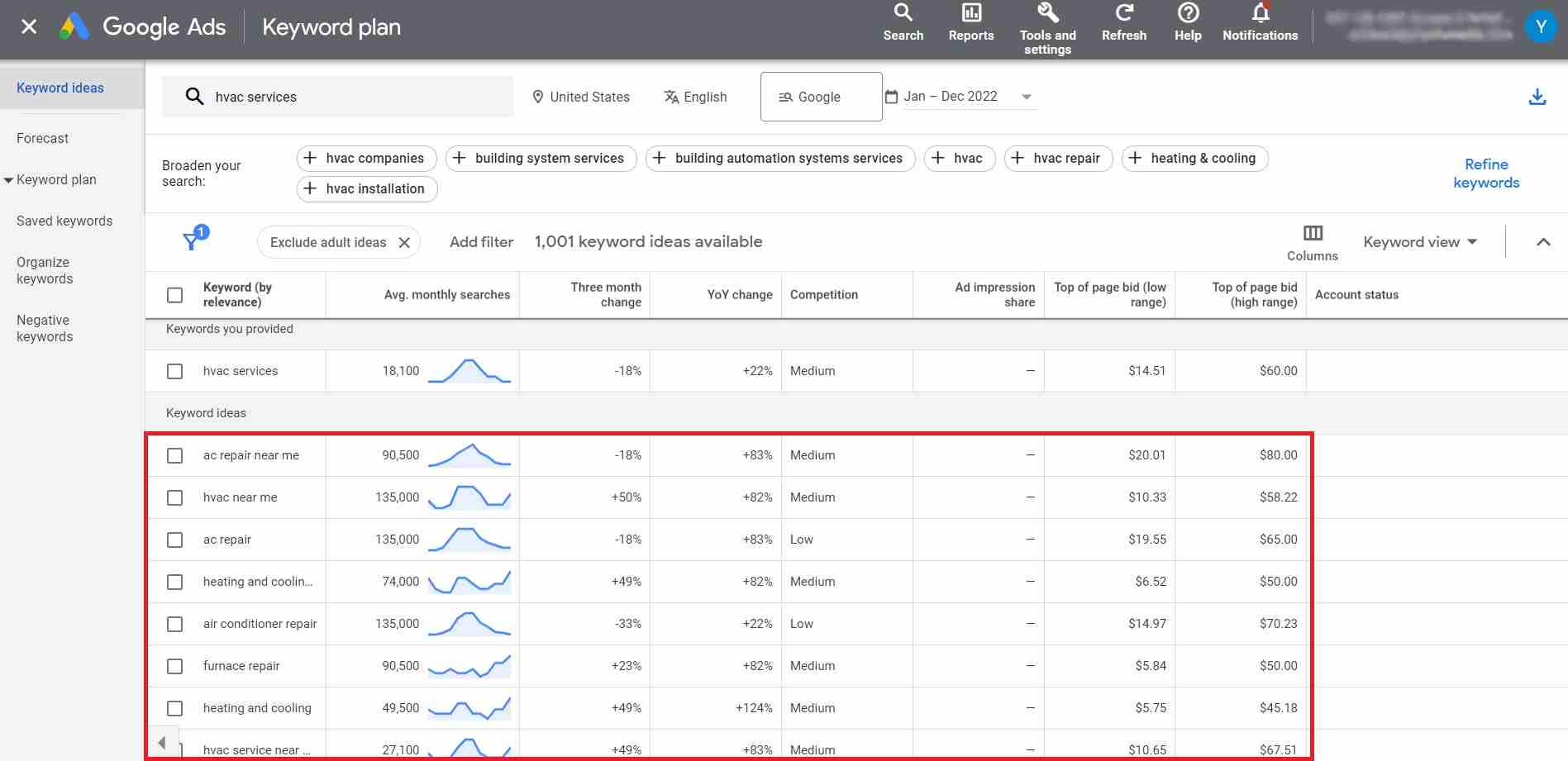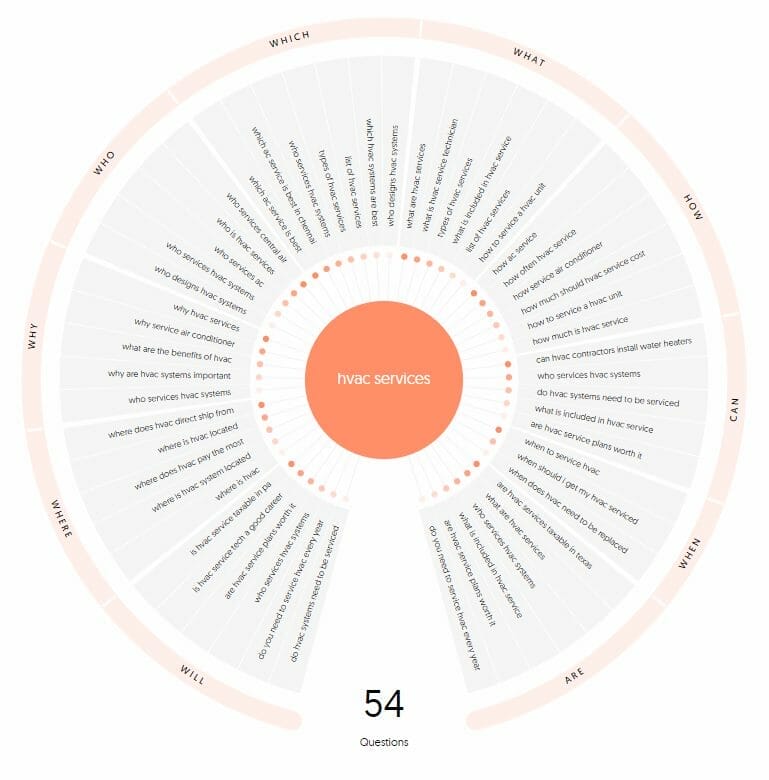People used to look for HVAC contractors in the Yellow Pages; now, the majority of people use search engines like Google or ChatGPT. In this blog, we’ll share with you effective techniques on how to do SEO for HVAC Companies that will help you get tons of traffic, lots of potential leads, and rank high on local search results!
Table of Contents
ToggleWhat is SEO?
Search Engine Optimization (SEO) is the process of making sure that your HVAC website gets found on search engines. It’s all about improving the quality of your site so that your potential customers can easily find you, not just on top of search results that are relevant to HVAC services, but also on local listings, and even on Google Maps!
There are three types of SEO, which are On-page SEO, Off-page SEO, and Technical SEO.
On-page SEO refers to the process of improving the quality of your HVAC web pages, which includes using relevant keywords and optimizing your title tags and meta descriptions, while Off-page SEO is all about improving the quality of your website by taking specific actions that can be done outside your website. This includes acquiring backlinks, social media marketing, and gathering reviews.
Lastly, Technical SEO is where you optimize the technical aspects of your HVAC website, which includes fixing broken pages, fixing pages that cannibalize other pages within your website, and a lot more in the latter part of this blog.
Want to start doing SEO for your HVAC website, but don’t have time to do it?
Why SEO for HVAC Companies?
It drives more traffic to your site.
As you optimize every element on your HVAC website, you’re increasing the chances of getting discovered by customers who are interested in HVAC services, no matter what stage they are in the buying cycle (e.g., awareness stage, consideration stage, or decision stage). This increased visibility will result in getting more clicks and calls, and could even help you get potential customers!
It builds your HVAC company’s credibility.
Another advantage of implementing SEO strategies on your website is that it helps establish your customers’ trust. If they always see your website on top of the search results page whenever they are looking for solutions on how to solve their HVAC concerns, it’ll give them the impression that you’re a reliable source of information. As a result, you will get lots of backlinks which help you rank higher on search results!
It’s a long-term strategy.
Although the results of your SEO efforts don’t happen overnight when done right, the Return on Investment (ROI) will be worth the wait. You just have to make sure that the strategies you use are properly aligned with your HVAC company’s goals and that you stay updated with the latest Google algorithm.
Local SEO
Local SEO is all about helping people in your own town or city find your HVAC business when they need it most. Think about it, if someone’s air conditioner stops working on the hottest day of summer, they’re not going to look for a company two states away, they want someone nearby who can come fast.
Local SEO makes sure your business shows up in places like Google Maps and the “near me” search results, so you’re the first option customers see when they type “AC repair near me” or “heating service in Los Angeles.” To do this, you need to set up and update your Google Business Profile with your phone number, address, hours, and photos so people can trust your business at a glance. Getting good reviews from happy customers is also super important because people usually pick the company with the most stars.
Local SEO also means making sure your business information looks the same everywhere online on your website, Yelp, Facebook, or other directories, so search engines know you’re real and reliable. Unlike general SEO, which helps you rank anywhere in the country, local SEO focuses on connecting you to people right in your community, the ones most likely to call you today when their air conditioner breaks or their heater stops working.
Why SEO Is Important For HVAC Companies
SEO is important for HVAC companies because it helps people find you at the exact time they need your help. Most homeowners don’t sit around thinking about their air conditioner or furnace until something goes wrong, and the very first thing they do is grab their phone and search online for someone nearby. If your HVAC business doesn’t show up on Google, chances are they’ll call your competitor instead.
SEO makes sure your website, your Google Business Profile, and even your customer reviews show up in front of people who are looking for heating and cooling services in your area. The higher you rank, the more likely someone is to click on your business, which means more phone calls, service requests, and long-term customers. Unlike paid ads that stop working as soon as you stop paying, SEO keeps bringing in customers over time, making it one of the smartest long-term investments an HVAC company can make. It’s not just about showing up; it’s about building trust, looking professional, and being the first name people think of when their home comfort is on the line.
Google Ads vs. SEO
When it comes to getting more customers, HVAC companies often wonder if they should use Google Ads or SEO, and the truth is, both can be helpful, but they work in very different ways.
Google Ads are like renting a billboard on the internet. You pay money to show up at the very top of search results, and the moment you stop paying, your ad disappears. This can bring in quick calls and customers, especially if you need business fast, but it can also get expensive because you pay every single time someone clicks your ad. You can check out our Google Ads for HVAC Companies to know more about Google Ads!
SEO, on the other hand, at first, it takes time and work; you need to build a strong website, create helpful content, and keep your information updated, but once it starts growing, it keeps working for you without paying for every click. With SEO, your HVAC company can show up naturally in Google search results, Google Maps, and even in “near me” searches, which helps you build trust because people usually trust organic results more than ads.
The best strategy for many HVAC companies is to use Google Ads for quick results while investing in SEO for long-term success, so you always have a steady flow of customers today and tomorrow.

Competitive Offer
Ignoring user experience, often called UX, is a serious mistake that can hurt both your search rankings and the way families feel when visiting your funeral home’s website. User experience is all about how easy, clear, and supportive your website feels. If a site is cluttered, loads slowly, has confusing menus, or makes it hard to find important details like contact information or service options, families may feel even more stressed during an already difficult time.
Search engines like Google notice when visitors quickly leave a site because it’s hard to use, and this can push your rankings down. For funeral services, where compassion and trust are essential, a poor user experience can send the wrong message. On the other hand, a well-designed website with clear navigation, gentle language, calming visuals, and quick access to help not only improves SEO but also shows families that your funeral home truly cares about their needs.
Got questions about SEO for HVAC companies?
On-page SEO techniques
In this section, we’ll walk you through the steps on how to do On-site SEO.
URL Slugs
A URL slug is the part of a website link that comes after the domain name. For example, in “https://nexgenairandplumbing.com/locations/los-angeles/irvine/”. Clean and simple slugs help both search engines and people quickly understand what the page is about. For HVAC companies, it’s best to use short, descriptive slugs with keywords, like /furnace-repair, /duct-cleaning, or /hvac-installation-[city]. Avoid long strings of numbers or random words because they confuse visitors and weaken SEO.
Title Tags
Your title tag is the clickable headline that shows up in Google search results. It should be clear, keyword-rich, and no longer than 60 characters. For example: “Irvine Air Conditioning, Heating, and HVAC Services”. Title tags are critical because they tell both search engines and potential customers what your page is about. Every page on your HVAC website should have a unique, well-optimized title that includes your service and location.

Meta Descriptions
A meta description is the short text shown under your title tag in search results. While it doesn’t directly affect rankings, it strongly impacts whether people click on your site. A good meta description is around 150–160 characters, includes your target keywords, and highlights your value. For example: “NEXGEN offers AC installation, maintenance, repair, heating installation, maintenance, repair, hot water heater services, and smart thermostat installation.” This makes your business more appealing when someone is choosing between search results.

Alt Tags
Alt tags (also called alt text) are short descriptions you add to images on your website. They help search engines understand what the image shows and also improve accessibility for people using screen readers. For example, instead of uploading a photo as “IMG123.jpg,” you can add an alt tag like: “Technician installing new HVAC unit in Dallas home.” This way, your images can also help you rank in Google Images while making your website more user-friendly.
Here’s an example of a well-written alt-tag:
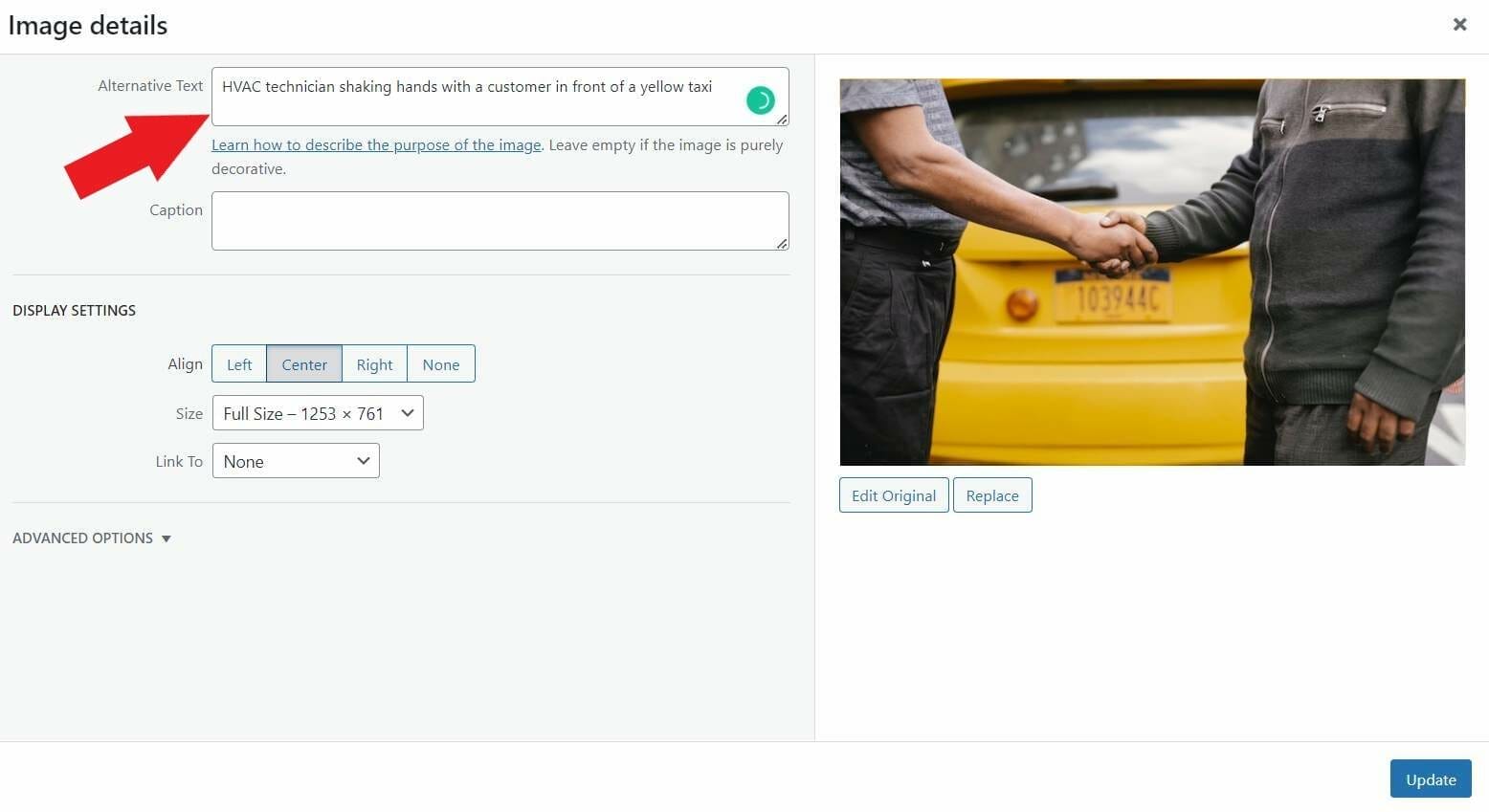
Content Marketing

Since your target audience is the ones who are interested in HVAC services, you should publish content that is related to heating, ventilation, and air conditioning concerns. This could be in the form of blog posts, videos, infographics, or e-books. Some of the topics that you should cover include the common problems faced by your customers, ways to fix them, and how to maintain them when the season changes, etc.
Internal Links
Internal links are links that connect one page of your website to another. For example, on your AC repair page, you can link to your maintenance page with text like: “We also offer seasonal HVAC maintenance services.” This helps search engines crawl your website more effectively, spreads out your website’s authority, and makes it easier for customers to find what they need. A strong internal linking strategy keeps people on your website longer, which improves SEO.

External Links
External links are links from your website to other trustworthy sources. For example, if you write a blog about saving energy, you could link to the U.S. Department of Energy’s website. This shows Google that you are referencing credible information and builds trust with your audience. But be careful only link to reliable, relevant websites. External links should always add value for your readers, not distract them.
Resize images
Visual information is much easier to understand than walls of text. Aside from that, adding images to your posts makes your content readable and easy to consume.
However, one of the most common reasons behind slow websites is having large image file sizes. Images that are displayed in high resolution consume tons of bandwidth as they load. To fix that, you should compress images (without ruining their quality) before uploading them to your website.
You can use image compression tools like Compress Now. This software allows you to choose the compression level of your images.
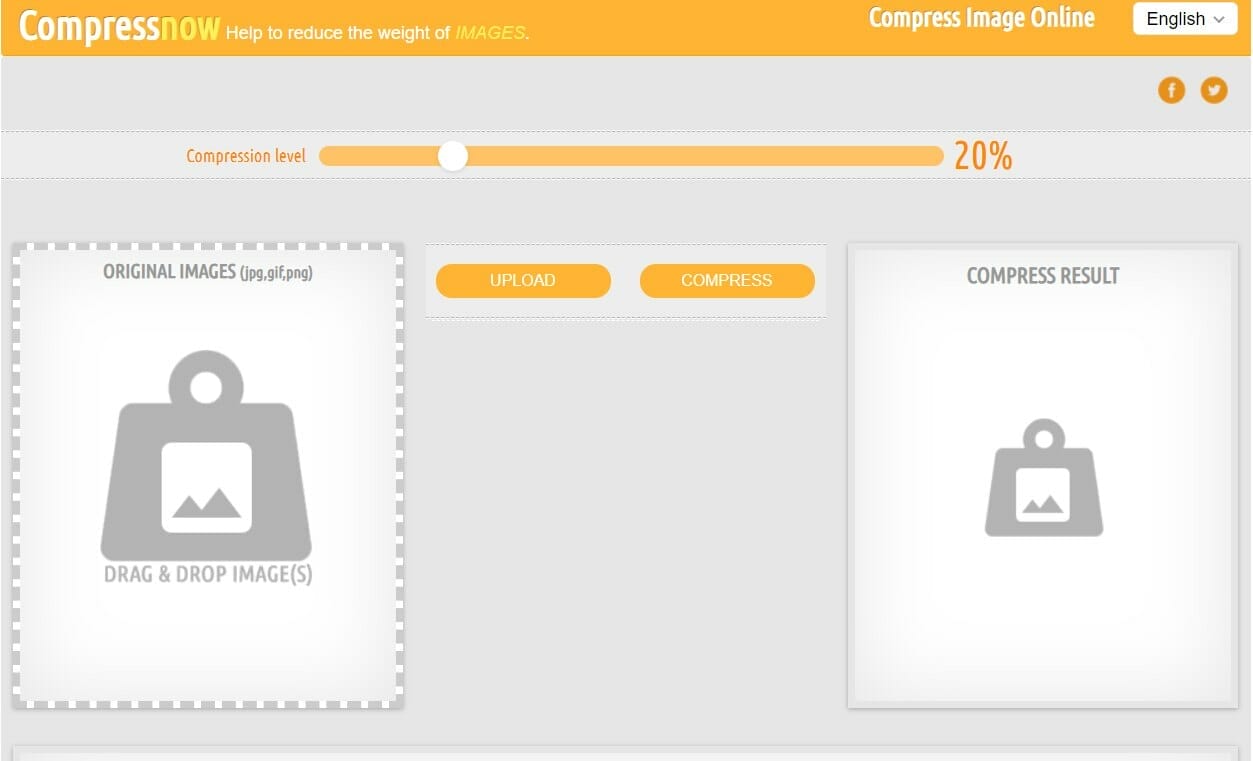
Use a responsive website design.
Having a functional web design means that your HVAC website looks good no matter what device is used by your page visitors. For example, if you visit a website using your phone, it automatically adjusts so it perfectly fits the screen of your phone, and all of the links and buttons are functionally working.
Using a responsive design will give you lots of benefits, such as making your site load faster, making it easier for users to find the page they are looking for on your HVAC website, and encouraging them to stay longer on your site. By providing a positive user experience to your page visitors, you could even help turn page visitors into your actual customers!
Improving Readability
Improving readability means making sure the words on your HVAC website are easy for anyone to understand, even if they don’t know anything about heating and cooling systems. Many HVAC sites make the mistake of using too many technical terms, like “SEER rating” or “variable speed compressor,” which can confuse people and make them leave the page.
Instead, your goal is to explain things in simple, clear sentences, just like you would if you were talking to a neighbor who asked about their air conditioner. Using short paragraphs, bullet points, and easy-to-read fonts helps people quickly find the information they need, like how much a service costs, what areas you serve, or how to book an appointment. Readability also means breaking up long blocks of text with headings, images, and even FAQs so customers don’t feel overwhelmed.
The easier your website is to read, the more likely people are to stay on it, trust your business, and call you when their AC or heater breaks down. Search engines like Google also notice when your site is user-friendly, so better readability can help you rank higher, too.
Optimize Website
Finally, you need to optimize your website as a whole. This means making sure your website is mobile-friendly, fast, secure, and easy to navigate. HVAC customers often search for services on their phones in emergency situations, so your website must be responsive and load quickly. An optimized site also uses proper headings (H1, H2, H3), a logical page structure, and clear call-to-action buttons like “Call Now” or “Schedule Service.” When your website is easy to use, customers stay longer and are more likely to contact you.
Need help creating a responsive website design for your HVAC company?
Understanding Keywords
Understanding keywords is like learning the exact words people type into Google when they need HVAC help. If someone’s heater breaks in the middle of winter, they might search “furnace repair near me,” and if their AC stops working in the summer, they might type “emergency AC repair in Los Angeles.”
Monthly Search Volume
Monthly search volume tells you how many times people type a certain word or phrase into Google in one month. For HVAC companies, this is really helpful because it shows which services people are looking for the most. For example, “AC repair near me” might get searched thousands of times each month in the summer, while “furnace installation” might become popular in the colder months.
By knowing the monthly search volume of different keywords, you can decide which ones are worth focusing on for your website and ads. High search volume means lots of people are looking for that service, but it usually comes with more competition from other HVAC businesses. Lower search volume keywords don’t get searched as often, but they can still bring in great leads because they’re usually more specific, like “best HVAC company for duct cleaning in Los Angeles.”
Tracking monthly search volume helps you plan, create the right content at the right time of the year, and make sure you’re showing up where customers are actually searching. In short, it’s like checking a map to see where the most traffic is, so you know the best road to take to reach your customers.
Keyword Difficulty
Keyword difficulty is a score that shows how hard it will be to rank on Google for a certain search word or phrase. For HVAC companies, this matters a lot because some keywords are much more competitive than others. For example, a broad keyword like “HVAC repair” might have a very high difficulty score because hundreds of companies in different cities are all trying to rank for it.
On the other hand, a more specific keyword like “emergency AC repair in Los Angeles” usually has a lower difficulty score, meaning you have a better chance of showing up higher in search results. Keyword difficulty is usually measured on a scale from 0 to 100, with higher numbers meaning tougher competition. A smart HVAC company doesn’t just chase the hardest keywords; instead, it balances between easy, medium, and hard ones to get quick wins and long-term growth.
Understanding keyword difficulty helps you avoid wasting time on words that are almost impossible to rank for and focus on ones where you can actually beat your local competitors. Think of it like sports, you wouldn’t challenge the best team in the country right away; you’d start by winning games in your own league first.
Short-Tail Keywords
Short-tail keywords are very short search phrases, usually just one to three words, that people type into Google when they’re looking for something. For HVAC companies, examples of short-tail keywords include “HVAC repair,” “AC installation,” or “furnace service.” These words get searched a lot every month because they are broad and cover many different situations.
The problem is that short-tail keywords are also very competitive, meaning lots of HVAC businesses across the country are trying to rank for them. If you only target short-tail keywords, it can be really hard to stand out, especially if you’re competing with big national companies. But they’re still important because they can bring in a large number of visitors to your site if you manage to rank high.
The trick is to use short-tail keywords as part of your strategy, while also mixing in long-tail keywords that are more specific and easier to rank for. Think of short-tail keywords like casting a big fishing net; you might catch a lot of fish, but it also takes more effort, and you’ll be competing with other people fishing in the same spot.
Long-Tail Keywords
Long-tail keywords are longer search phrases, usually three or more words, that people type into Google when they know exactly what they’re looking for. For HVAC companies, examples include “emergency AC repair near me,” “best furnace installation in Los Angeles,” or “affordable duct cleaning services in Los Angeles.” These searches don’t get as many total searches each month as short-tail keywords, but the people typing them in are often more serious about hiring someone right away.
That means long-tail keywords usually bring in higher-quality leads, customers who are ready to call, schedule, or buy. They’re also less competitive, which makes them easier for local HVAC companies to rank for compared to broad terms like “HVAC repair.” Another benefit is that long-tail keywords often match real questions or problems homeowners have, which gives you ideas for blog posts, FAQs, and service pages. Think of long-tail keywords like fishing with a spear instead of a net; you might not catch as many fish at once, but the ones you do catch are exactly what you want. For HVAC businesses, using long-tail keywords is one of the smartest ways to beat bigger competitors and attract the right local customers.
Keyword Research Tools
Another on-page technique that you should try is implementing relevant keywords on your website. This includes your headings, title tags, meta descriptions, image file name, alt-tags (as long as it makes sense), and throughout your content.
You should also include relevant keywords throughout your content and long-tail keywords in your title (to increase the chances of ranking on relevant search queries) because it would be impossible to rank for highly competitive keywords than specific ones.
Here’s a list of where you can find relevant keywords for your HVAC business:
- Google’s Related Searches

- Google’s Keyword Planner

- Google’s Auto-complete suggestions

- Answer The Public

- Ahrefs Free Keyword Generator
Ahrefs offers a free tool where you type in a seed keyword (like “HVAC repair” or “air conditioning service”), and it gives you hundreds of related keyword ideas.

Why “HVAC near me”is a good keyword
-
High Buyer Intent: Someone searching “HVAC near me” usually has an urgent need — their AC is broken, their heater isn’t working, or they need maintenance. This means they’re ready to call and hire immediately.
-
Local Relevance: HVAC services are local by nature. Customers don’t want a company across the country — they want a trusted local technician nearby. This keyword ensures you show up in Google Maps, Local Pack, and local search results.
-
Direct Conversions: Unlike broad HVAC terms, this keyword captures people at the decision stage — they’re not researching, they’re looking for help right now.
-
Competitive Advantage: Ranking for “HVAC near me” positions your business ahead of local competitors, especially during peak seasons when demand is high.
The keyword “HVAC meaning” is not a good keyword because it attracts the wrong type of audience and doesn’t generate business leads. Here’s why:
Purely Informational Intent
Someone searching “HVAC meaning” just wants to know what HVAC stands for (Heating, Ventilation, and Air Conditioning). They are not looking to hire a company or book a repair.
Wrong Audience
This keyword mostly attracts:
-
Students doing research.
-
Writers/bloggers needing a definition.
- General readers curious about the acronym.
None of these people are going to call you for HVAC service.
No Commercial Value
Even if your site ranks, traffic from this keyword will bring zero conversions. Visitors will read the definition and leave — no bookings, no sales.
Wasted SEO Resources
It’s better to focus on keywords with service-based intent like “HVAC repair near me,” “AC installation near me,” or “emergency HVAC service,” which actually bring in paying customers.
Steps on how to do manual keyword research:
Step 1: On your preferred search engine, type in the keyword you want to use on the blog that you’re planning to create. In this example, let’s use “HVAC maintenance tips for homeowners.”

Step 2: Then, from the search results page, you’ll have an idea of the type of content that ranks for the keyword you are going for. You’ll see if most of the results are long-form articles, category pages, Top-10 best lists, and the like. Remember that when you start creating content for your HVAC website, it should satisfy what the searchers are looking for.
Go through each post on the search results page. In this example, let’s check the content of the blog that ranks #1 for the keyword “HVAC maintenance tips for homeowners.”
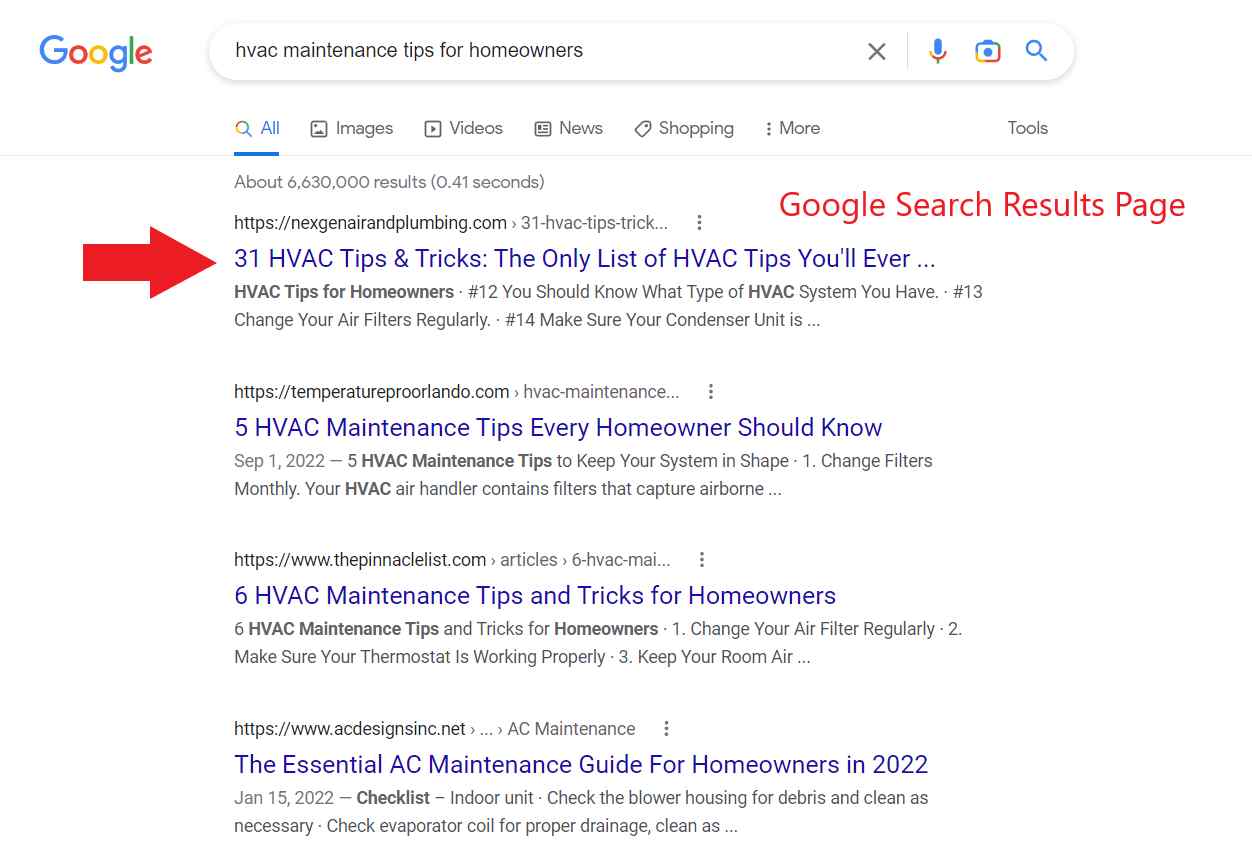
Step 3: Then, press Ctrl + F followed by your chosen keyword.
For example, if you want to check how many times the phrase “HVAC tips” was used, type in that word and press enter. It’ll show you the keyword density along with the specific areas where the phrase was used throughout the content.
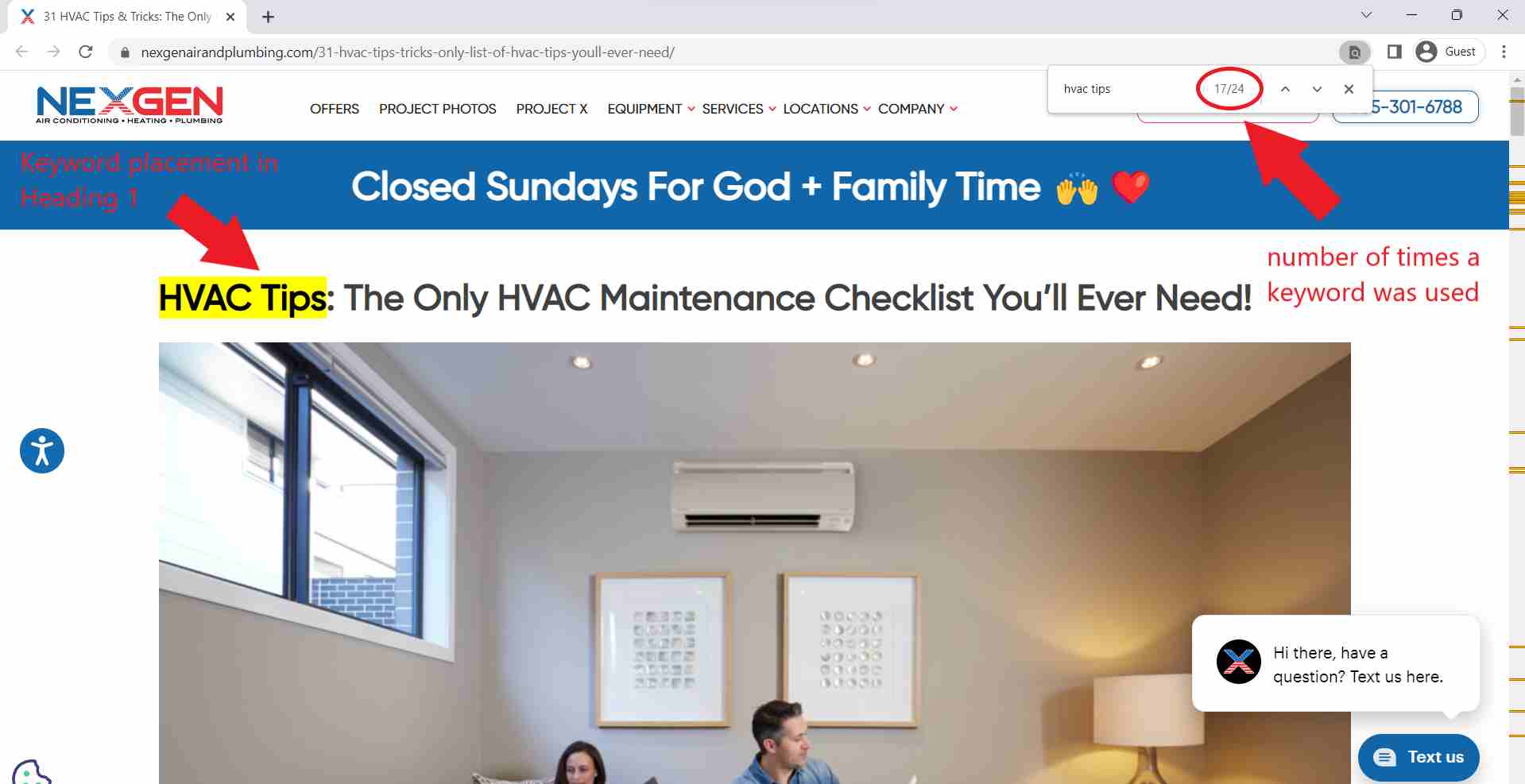
Step 4: Repeat the same steps for the rest of the pages shown on the search results. Once you’ve gathered enough data, you can apply those strategies to your HVAC articles.
Don’t Know The Right Keywords To Use?
Understanding Search Intent
Understanding search intent means figuring out the real reason why someone is typing certain words into Google. Not every person who searches for “air conditioner” is ready to hire an HVAC company; some just want to know how an AC works, while others might be looking for a store to buy one, and a few are ready to call a repair service right away.
Informational Intent
Informational intent is when someone searches on Google because they just want to learn something, not necessarily hire a company right away. For HVAC companies, this might look like a person typing “why is my AC blowing warm air,” “how often should I change my furnace filter,” or “what size air conditioner do I need for my home.” These people aren’t ready to buy or call for service, yet they’re looking for answers, tips, or explanations. Even though they may not become customers today, informational searches are still very valuable.
By creating blog posts, FAQ pages, or helpful guides that answer these common questions, your HVAC company can show up in Google and build trust with people. Later, when that same person actually needs a repair or installation, they’ll remember your company because you were the one who helped them earlier.
Google also rewards websites that provide useful information by ranking them higher, so answering these questions is good for both customers and search engines. Think of informational intent as planting seeds by helping people learn today; you increase the chance they’ll call you tomorrow when they really need HVAC services.
Navigational Intent
Navigational intent is when someone searches on Google because they already know exactly which company, brand, or website they want to visit. They’re not looking for general answers or comparing options; they’re just trying to find the right place online. For HVAC companies, this might look like a customer typing “ABC Heating and Cooling website,” “Carrier furnace service near me,” or even your business name, like “Cool Air HVAC phone number.”
These searches happen when people already have you in mind, maybe because they’ve seen your truck, got a referral, or read your reviews. That’s why it’s important to make sure your website, Google Business Profile, and social media pages are easy to find and show up correctly when people search for your brand.
If your online presence is weak, customers might get lost and accidentally click on a competitor instead. Navigational intent may seem simple, but it’s one of the most important types of searches because it usually comes from people who already trust you and are very close to calling or booking a service. Making your business easy to find online ensures that when people look for you specifically, they don’t end up somewhere else.
Commercial Intent
Commercial intent is when someone searches on Google because they’re getting ready to make a decision, but still want to compare their options first. They know they need HVAC help, but they’re not sure which company, product, or service to choose. For example, a person might search. “best HVAC companies near me,” “top-rated furnace brands,” or “AC repair vs replacement cost.” These searches show that the person is serious about solving their problem, but they’re still shopping around before calling.
For HVAC companies, this is a golden opportunity to stand out. By creating pages with customer reviews, comparison guides, or “why choose us” content, you can show potential customers why your company is the better choice. You can also highlight things like warranties, financing options, or 24/7 emergency service to answer the questions people usually compare.
Commercial intent is powerful because it’s often the last step before someone takes action. If you show up at this stage with clear, helpful, and trustworthy information, you make it much more likely that the customer will pick up the phone and call your HVAC business instead of your competitor.
Transactional Intent
Transactional intent is when someone searches on Google because they are ready to take action right now. These are the people who already know what they need and are just looking for the fastest way to get it. For HVAC companies, this might look like someone typing “book AC repair near me,” “schedule furnace installation in Los Angeles,” or “24/7 emergency HVAC service.”
These searches are the most valuable because they usually turn into phone calls, appointments, and paying customers. When someone has transactional intent, they don’t want to read a long blog post or compare ten different brands; they just want a clear service page, a phone number, or a button that says “Call Now” or “Book Service.”
That’s why it’s important for HVAC companies to have easy-to-use websites with click-to-call buttons, simple contact forms, and clear pricing or offers. If your site makes the booking process smooth, you’re much more likely to win the job. Transactional intent is the end of the customer journey, and if your business shows up here, it means you’ve captured someone at the exact moment they’re ready to hire you.
Struggling With Setting Up Your Website To Have Good SEO? We Can Help!
Off-page SEO techniques
In this section, we’ll walk you through the steps on how to do Off-site SEO.
Acquire backlinks
Backlinks refer to the links that “link back” to your website. It’s one of the most important factors in SEO because the number of backlinks you get is one way of telling you that you are providing valuable content to your target audience. Aside from that, it’s also one of the most effective link-building techniques, which can help your HVAC site get more traffic.
You can also use Semrush’s free backlink checker.

Social media marketing

Consumers, whether they are looking for HVAC services or not, most of them are always on social media. With over 4.26 billion social media users in the world, posting on this platform will surely help you get discovered by your potential customers. For your HVAC c
Gather lots of good reviews.
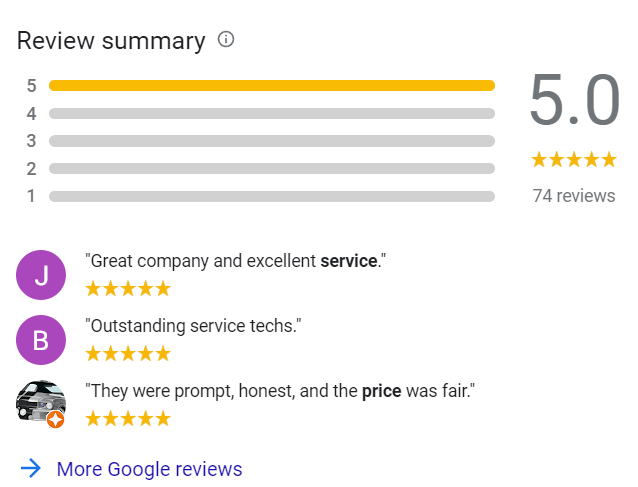
54.7% of consumers read online reviews before purchasing a product or service. It’s because online reviews serve as a guide to whether engaging with your brand is worth it or not.
In fact, according to Google, businesses that have lots of positive reviews have a chance of ranking high on local searches. So, if you don’t yet have that many reviews on your Business profiles, you should probably start collecting them.
Want to know several ways to ask your customers for reviews? Check out our blog on How to get reviews for HVAC companies to learn more.
Local Listings
Local listings are online directories or websites where your HVAC business information, like your name, address, phone number, and services, gets published so more people can find you. Think of them like digital phone books, but way more powerful because they show up in Google searches, maps, and even voice searches when someone says, “Find an AC repair company near me.”
Popular local listings include Yelp, Angi, HomeAdvisor, Thumbtack, and even Facebook. When your HVAC company is listed in many trusted places online, search engines like Google see you as more reliable and are more likely to show your business higher in results. The key is to keep your information the same everywhere. This is called NAP consistency (Name, Address, Phone).
If your phone number or address is different on one site, it can confuse both customers and search engines. Local listings also often let customers leave reviews, which makes them another great way to build trust and attract more calls. For HVAC companies, being in the right local listings means more visibility, more leads, and a better chance of beating competitors who don’t take the time to get listed.
Content Marketing
Content marketing is all about creating helpful information that answers people’s questions and shows them why your HVAC company is the right choice. Instead of just telling customers “we fix air conditioners,” content marketing lets you prove your knowledge by sharing tips, guides, and answers online. For example, you could write a blog post like “5 Ways to Lower Your Energy Bill This Summer” or make a short video showing how to change an air filter.
This kind of content builds trust because people see that you know what you’re talking about and that you care about helping, not just selling. Search engines also love fresh, useful content, so every new article or video gives you another chance to show up in Google searches when people type in things like “why is my AC making noise” or “best furnace for small homes.”
Over time, your website becomes a go-to resource for homeowners, which keeps them coming back and makes them more likely to call you when they need repairs or a new system. Unlike ads that disappear once you stop paying, good content stays online, bringing in traffic and leads for months or even years. For HVAC companies, content marketing is like planting seeds; you keep adding helpful content, and soon you’ll grow a steady stream of customers who already trust your business.
AI SEO (LLM SEO, GEO, GSEO, ChatGPT SEO)
As search engines continue to evolve, AI-powered platforms like ChatGPT, Gemini, and Perplexity are starting to play a bigger role in how people find information online. This shift has created a new concept known as AI SEO sometimes called LLM SEO (Large Language Model SEO), GEO (Generative Engine Optimization), or GSEO (Generative Search Engine Optimization).
Unlike traditional SEO, which focuses mainly on ranking inside Google’s search engine, AI SEO is about making sure your content is discovered, summarized, and recommended by AI assistants and generative search tools.
What AI SEO Is
AI SEO is the practice of optimizing your content so that AI-driven platforms can find, understand, and present it as a reliable answer to user questions. Instead of just competing for a spot on Google’s first page, businesses now also compete to be the source that AI assistants cite, summarize, or recommend.
For example:
-
Someone might ask ChatGPT for “the best HVAC company in Dallas.” If your website has unique, trusted, and well-structured information, AI may highlight your business in its response.
-
Or a user might search in Perplexity AI for “furnace repair tips.” If your content is detailed, original, and easy to summarize, Perplexity may link directly to your site as a source.
In short: AI SEO is about being the source AI trusts when it’s pulling answers.
Similarities Across AI Platforms
Even though different AI platforms work in slightly different ways, they share some common priorities:
-
High-quality, trustworthy content
-
AI systems need reliable sources.
-
-
Fresh and updated information
-
AI tends to favor recent articles, blog posts, or videos.
-
-
Unique insights
-
If your content simply repeats what’s already online, AI won’t find it valuable.
-
-
Clear formatting
-
Organized content with headings, bullet points, and summaries is easier for AI to parse.
-
Key Differences Between ChatGPT, Gemini, and Perplexity
Each AI tool has its own way of ranking and summarizing information. While this changes often as updates roll out, here’s a general breakdown:
-
ChatGPT prioritizes clarity, authority, and trusted domains. It tends to draw from high-authority websites, PR articles, and structured guides that are written clearly. It often blends multiple sources together, so unique data and original insights help your content stand out.
-
Gemini (Google’s AI) prioritizes freshness and alignment with Google’s search signals. Since it’s tied closely to Google Search, it leans heavily on recent content, websites with strong SEO, and multimedia like YouTube videos.
-
Perplexity prioritizes citations and transparency. Unlike ChatGPT, which often summarizes without links, Perplexity highlights and links to its sources directly. That means if your content is cited, you get visible traffic and brand recognition.
Why Unique Content Matters
One of the biggest factors in AI SEO is originality. If your content looks like everything else online, it’s less likely to be used by AI platforms.
-
Content that has no new insights
-
AI already knows it, so your site doesn’t get highlighted.
-
-
Content with fresh, original information (like unique case studies, customer stories, or industry stats) → AI doesn’t have this, which makes your site more valuable and more likely to be cited.
Put simply: The more new information you provide that AI doesn’t already know, the higher your chances of ranking in AI-driven search.
Other Ranking Boosters for AI SEO
-
YouTube Videos
-
AI tools (especially Gemini) pull summaries and insights directly from video content. Creating short, educational HVAC videos is a smart move.
-
-
PR Articles & Press Releases
-
These help establish authority and trust, which AI platforms favor.
-
-
Structured Data
-
Schema markup, FAQs, and clear headings help AI crawl and summarize your site.
-
Technical SEO techniques
The main goal of technical SEO is to make it easier for search engines like Google to crawl and index your HVAC web pages. In this section, we’ll share with you the technical aspects that you can optimize on your website.
Optimize page loading speed.
Another thing that you should check when optimizing the technical aspects of your HVAC website is your page loading speed. According to a study, the first five seconds of your page loading time are crucial to your page visitors. The longer your page takes to load, the higher the chances a page visitor will leave your site without performing any action.
Website Security (HTTPS)
Having a secure website (HTTPS) is no longer optional it’s a must. HTTPS means that your website uses encryption to protect customer information. Search engines like Google also give ranking preference to secure websites. Customers are more likely to trust your business if they see the little padlock icon in the browser bar. If your HVAC website still runs on HTTP instead of HTTPS, you should get an SSL certificate from your hosting provider right away.
Page Speed
A slow website can drive customers away before they even see your services. Page speed is a critical ranking factor because search engines know that people don’t like waiting. If your HVAC site takes more than a few seconds to load, you’re losing potential leads. You can improve speed by compressing images, reducing unnecessary code, and using caching tools. A fast website not only ranks better but also creates a smoother experience for visitors.
Keyword Cannibalization
Keyword cannibalization happens when multiple pages on your website target the same keyword. This confuses search engines because they don’t know which page to rank, and it can cause all your pages to perform worse. For example, if you have three separate pages all targeting “AC repair Los Angeles,” they end up competing against each other. Instead, you should combine similar content into one strong page and make sure each page has a unique focus.
Fix Duplicate Content
Search engines dislike seeing the same content repeated across multiple pages. Duplicate content can hurt your rankings because it looks like your website doesn’t provide unique value. HVAC companies sometimes run into this problem when they create multiple city pages with almost identical text. The fix is to customize each page with unique, location-specific information so that every page provides original value.
Fix Broken Links
Nothing hurts user experience faster than clicking a link and landing on a 404 error page. Broken links confuse both visitors and search engines, signaling that your site isn’t maintained. Regularly check your HVAC website for broken internal or external links and update or remove them. This small task can make your website look more professional and help keep visitors on your site longer.
You can use Ahrefs broken link checker to know have many broken links your site has.

Improve User Experience (UX)
Search engines want to recommend websites that people enjoy using. That’s why user experience (UX) is such an important part of technical SEO. For HVAC companies, this means making sure your site is easy to navigate, loads quickly, and has clear calls-to-action like “Call Now” or “Schedule Service.” A site that is clean, organized, and easy to use keeps customers engaged and encourages them to contact you.
Mobile Friendly Website
Having a mobile-friendly website means your HVAC company’s site looks good and works smoothly on a phone or tablet, not just on a computer. This is super important because most people who need HVAC help are searching on their phones usually when something breaks and they’re in a hurry. If your website is hard to read, the buttons are too small, or the pages take forever to load, people will get frustrated and leave before calling you. A mobile-friendly site fixes that by making the text easy to read, the buttons big enough to tap with your finger, and the contact information easy to find right away.
It also helps search engines like Google trust your website more, which means they’re more likely to show your business higher in local results. Think of it like this, if someone’s heater stops working on a freezing night, they want to call the first company they find, if your site is mobile-friendly with a click-to-call button, you’re much more likely to get that job. For HVAC companies, a mobile-friendly website isn’t just nice to have, it’s one of the most important tools for turning online searches into real customers.
Monitoring Your Website
Monitoring your website means keeping an eye on how well it’s working and making sure it continues to bring in new customers. For HVAC companies, your website isn’t just an online brochure it’s like your digital storefront that people visit before deciding to call you. If something goes wrong, like broken links, pages that load too slowly, or forms that don’t send messages, you could be losing customers without even knowing it.
By monitoring your site with tools like Google Analytics, you can see how many people visit your site, which pages they read the most, and how they found you in the first place. This helps you figure out what’s working and what needs fixing. For example, if a lot of people visit your “AC repair” page but no one calls, maybe the phone number isn’t easy to find or the page isn’t convincing enough. Monitoring also helps you catch problems early, like sudden drops in traffic or security issues, so you can fix them before they hurt your business. Think of it like HVAC maintenance just as you recommend homeowners check their systems regularly to avoid breakdowns, you should check your website often to make sure it’s running smoothly and keeping the calls coming in.
SEO can be time-consuming. Our digital marketing experts are here to help.
Common SEO Mistakes To Avoid
One of the biggest problems HVAC companies face with SEO isn’t just what they do right it’s avoiding the mistakes that can quietly hurt their website. A common mistake is keyword stuffing, which means cramming too many keywords like “AC repair” over and over into a page. This makes the writing sound robotic, and Google may even rank the site lower.
Keyword Stuffing And Over Optimization
Keyword stuffing and over-optimization happen when a website tries too hard to rank on Google by cramming in the same keywords over and over. For example, an HVAC company might write a sentence like, “If you need HVAC repair, our HVAC repair service is the best HVAC repair in town for HVAC repair.”
Not only does that sound strange and unnatural, but it also makes the website hard to read, and Google actually punishes sites that do it. Over-optimization can also mean using too many exact-match keywords in titles, headings, or even links, instead of writing in a natural way. While it’s important to include keywords like “AC repair in Los Angeles” or “furnace installation,” you should mix them in with natural language so the page reads smoothly. The goal is to help customers, not trick search engines.
Google is smart enough to understand related words, so saying “air conditioner repair” or “fixing a broken AC” works just as well as repeating the same keywords the same keyword a hundred times. For HVAC companies, the best approach is to write content that feels helpful and easy to read, with keywords sprinkled in naturally. Think of it like seasoning food you want just the right amount of salt and spices, not so much that it ruins the whole dish.
Neglecting Mobile Optimization
Neglecting mobile optimization means forgetting to make sure your HVAC company’s website works well on phones and tablets. This is a big mistake because most people search for heating and cooling services on their phones, usually when something breaks and they need help fast. If your website isn’t mobile-friendly, it might load too slowly, the text could be too small to read, or the buttons might be hard to tap.
When that happens, customers will likely get frustrated and click away to a competitor whose site is easier to use. Google also notices when websites aren’t mobile-optimized and may rank them lower in search results, which means fewer people will even see your business online.
For HVAC companies, this can be especially costly because losing just a few emergency calls can mean losing a lot of money. A mobile-friendly site should load quickly, fit nicely on small screens, and make it easy for customers to call, book, or find your address. Ignoring mobile optimization is like leaving your phone off the hook people are trying to reach you, but they can’t get through.
Ignoring User Experience
Ignoring user experience means forgetting about how customers actually feel when they visit your HVAC company’s website. Even if you have the right keywords. Even if you have the right keywords and rank high on Google, people won’t stay on your site or call you if it’s confusing, slow, or hard to use. A bad user experience might include tiny text that’s tough to read, pages that take forever to load, menus that are hard to navigate, or a phone number hidden at the bottom where no one can find it.
When this happens, visitors usually leave your site and call a competitor instead. Google also pays attention to user experience: if people keep leaving quickly, your rankings can drop. On the other hand, a good user experience means the website is clean, easy to read, fast to load, and makes important things like your services, phone number, and “book now” button easy to spot.
For HVAC companies, user experience is especially important because customers are often in a rush when their AC or heater breaks. If your site makes their search simple and stress-free, you’re far more likely to earn their trust and get their business. Ignoring user experience is like having a messy, hard-to-find office people will just go to the company next door.
Key Takeaway
Search Engine Optimization is one of the most effective tactics that you can do to stay on top of the minds of your potential customers. Although it takes time before you see results, when done right, it could be a good long-term strategy for HVAC companies like yours. Just follow the best practices we’ve mentioned earlier and you will see tons of traffic and business opportunities coming your way.


